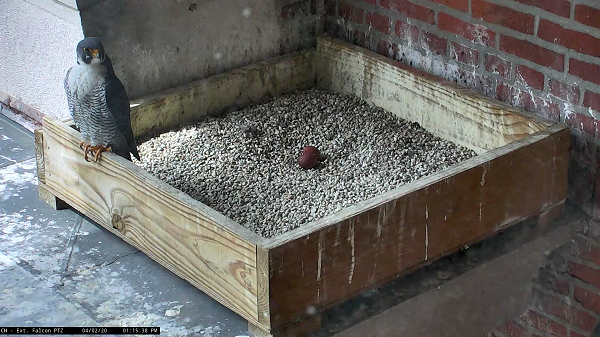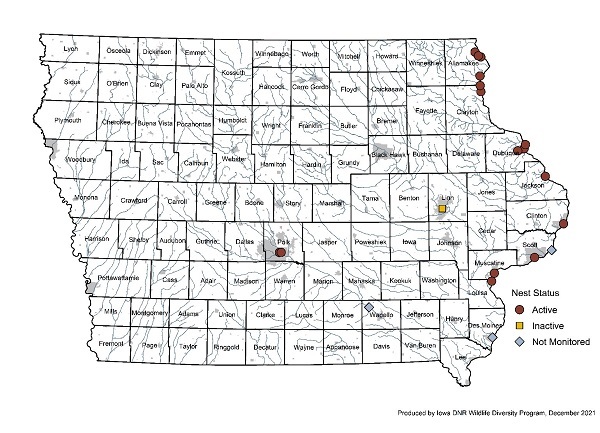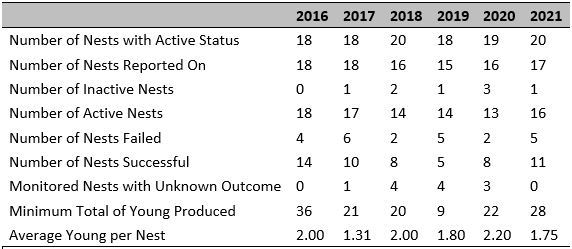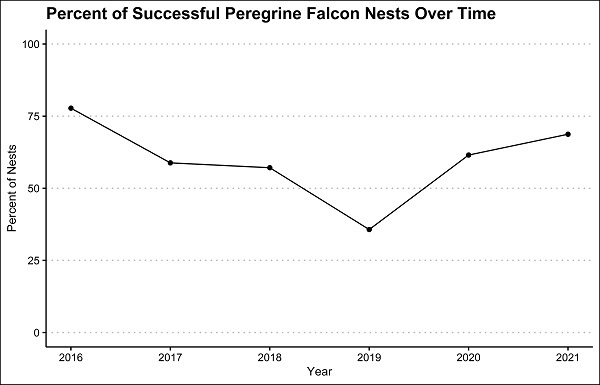2021 Nesting Report for Peregrine Falcon
March 9th, 2022 by Ric Hanson
Breeding Peregrine Falcons (Falco peregrinus) disappeared from Iowa in the 1950s because of wide spread use of the pesticide DDT. Peregrine falcons historically nested on cliff ledges, but have also adapted to nest on human-made structures like tall buildings and bridges.

Two eggs sit in the shallow “scrape” that serve as nests for Peregrine Falcons
After DDT was banned in the U.S. in 1972, the Iowa DNR began a Peregrine Falcon restoration program in 1989 with 23 birds released in Cedar Rapids followed by another 19 released in Des Moines in 1991. Between 1989 and 2003, a total of 169 birds were released in Iowa feeding into a regional restoration effort that saw 875 birds released across the Midwest. In 1999, the first pair of birds nested on their historic nesting grounds along the Mississippi River bluffs. Most of Iowa’s current Peregrine Falcon nests occur in the eastern half of the state in three main environments: Urban, Mississippi River bluff faces and energy plant towers.

Each year, monitoring of nest sites is accomplished by a network of volunteer and professional surveyors. The Raptor Resource Project monitors and bands birds at a number of Peregrine nest sites in the Northeastern corner of the state. Several of the nest sites are on power plants which have restricted access so we rely on employees who not only monitor the nest sites but are often wonderful stewards for the birds. Surveyors collect data on the nest’s activity and whether the pair are successful in producing fledglings.
There were 20 known nest sites in 2021 which had recently been active or were suspected active. One new nesting site was established and three sites along the Mississippi River that were inactive in 2020 were active in 2021. Reports were received on 17 of the 20 sites (Table 1). Sixteen of the 17 monitored nests were active, one inactive. Of the 16 active nests, 5 failed to produce young and 11 were successful. A minimum total of 28 young were fledged from the 11 successful nests. An average of 1.75 young were produced at each nest with a known outcome.

Comparing 2021 data to recent years indicates that 2021 was a good year for breeding Peregrines, with more active/recently active nest sites than in 2020 and the second highest percent of successful active nests (69%) since 2016 (Figure 2). A minimum of 28 Peregrine Falcons fledged in Iowa in 2021, the second highest number since 2016. Overall, Iowa’s nesting population of Peregrine Falcons appears to be stable, with birds generally returning to historic nesting sites each year, but this recovering population continues to warrant annual monitoring.

In future years, the DNR will continue to monitor Peregrine Falcon nest sites with the partnership of volunteers and others who care about falcons in Iowa. Falcon nest sites can be very challenging to monitor because of their location and the territoriality of the birds so any data received is much appreciated. Monitors are needed at nest sites in the Quad Cities and Burlington. Please contact the DNR’s Volunteer Wildlife Monitoring Program coordinator if you’d like to help, vwmp@dnr.iowa.gov.





